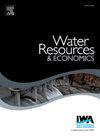评估科罗拉多河流域水的经济价值:水文经济学分析
IF 1.9
3区 经济学
Q2 ECONOMICS
引用次数: 0
摘要
与世界上许多流域一样,由于气候变化和人口增长等因素,横跨美国和墨西哥部分地区的科罗拉多河流域的水供需失衡正在加剧。本文提出了一个新的水文经济模型,该模型包括220万英亩的灌溉农田、379个城市、3340万人口和近90%的流域水力发电能力。该模型通过估算不同地区和部门的水资源价值,为评估政策干预提供了一个强有力的框架。我们发现,该流域的用水每年产生206亿美元的效益,其中城市用水183亿美元,农业用水14亿美元,水电用水8.74亿美元。研究结果揭示了各州和各个部门内部和之间水边际价值的巨大差异,为设计基于补偿的政策和支持高效水交易系统的发展提供了关键见解。本文章由计算机程序翻译,如有差异,请以英文原文为准。
Assessing the economic value of water in the Colorado River Basin: A hydroeconomic analysis
As in many basins worldwide, the imbalance between water supply and demand in the Colorado River Basin, which spans parts of the United States and Mexico, is intensifying due to factors such as climate change and population growth. This paper introduces a novel hydro-economic model encompassing 2.2 million acres of irrigated farmland, 379 cities with a combined population of 33.4 million, and nearly 90 % of the basin's hydropower capacity. The model offers a robust framework for evaluating policy interventions by estimating the value of water across regions and sectors. We find that water use in the basin generates $20.6 billion in annual benefits, $18.3 billion from urban use, $1.4 billion from agriculture, and $874 million from hydropower. Results reveal substantial variation in the marginal value of water within and across states and sectors, providing key insights for designing compensation-based policies and supporting the development of efficient water trading systems.
求助全文
通过发布文献求助,成功后即可免费获取论文全文。
去求助
来源期刊

Water Resources and Economics
Environmental Science-Water Science and Technology
CiteScore
5.00
自引率
0.00%
发文量
17
审稿时长
51 days
期刊介绍:
Water Resources and Economics is one of a series of specialist titles launched by the highly-regarded Water Research. For the purpose of sustainable water resources management, understanding the multiple connections and feedback mechanisms between water resources and the economy is crucial. Water Resources and Economics addresses the financial and economic dimensions associated with water resources use and governance, across different economic sectors like agriculture, energy, industry, shipping, recreation and urban and rural water supply, at local, regional and transboundary scale.
Topics of interest include (but are not restricted to) the economics of:
Aquatic ecosystem services-
Blue economy-
Climate change and flood risk management-
Climate smart agriculture-
Coastal management-
Droughts and water scarcity-
Environmental flows-
Eutrophication-
Food, water, energy nexus-
Groundwater management-
Hydropower generation-
Hydrological risks and uncertainties-
Marine resources-
Nature-based solutions-
Resource recovery-
River restoration-
Storm water harvesting-
Transboundary water allocation-
Urban water management-
Wastewater treatment-
Watershed management-
Water health risks-
Water pollution-
Water quality management-
Water security-
Water stress-
Water technology innovation.
 求助内容:
求助内容: 应助结果提醒方式:
应助结果提醒方式:


